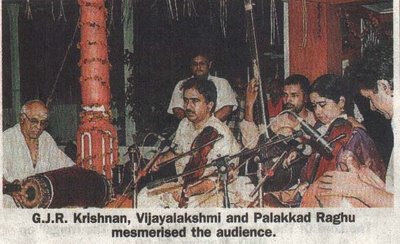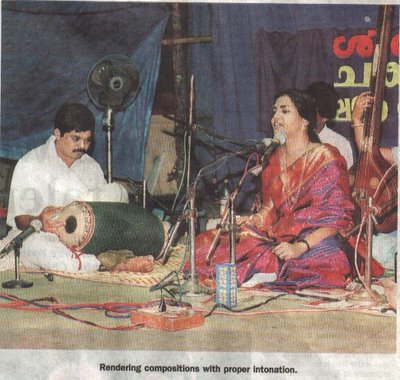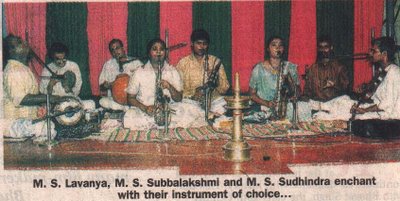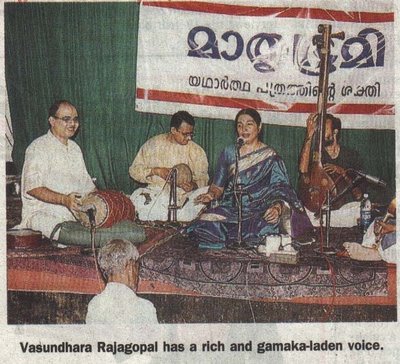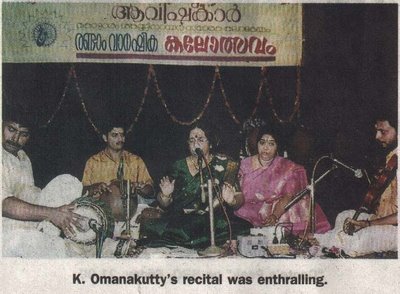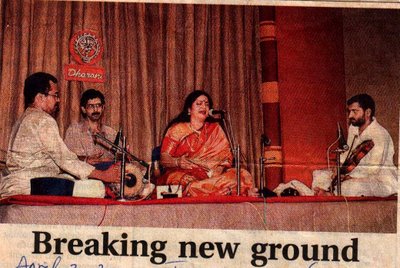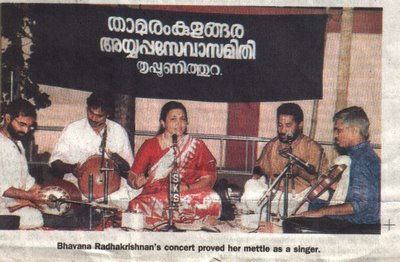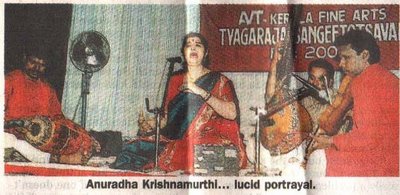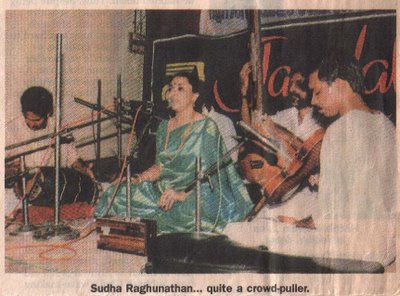By courtesy The Hindu
After the halcyon days of M.L. Vasanthakumari, Radha-Jayalakshmi, P. Leela and the like, it is rarely that a rasika comes across women vocalists who can pack real punch, all through a vocal concert, with due regard to the tenets of katcheri dharma. It was with a correct emphasis on tradition that Sivadarsana, settled now in Tripunithura, presented the inaugural vocal recital at the precincts of the Siva temple at Ernakulam, in connection with the on-going festival there. In these days even when famed vocalists dispense with the practice of beginning a concert with a varnam, she came out with Ninne kori,a varnam created by Thaachoor Singarachari in Vasantha set to Aadi. This evidently helped in ushering the right mood. . Sree Mahaganpathim in Ataana, credited with Mysore Maharaja in Aadi was garnished with kalpanaswara, and in its wake came Sree Jaalandhra in Gambheera Natta, by the same Royal composer, spiced by a sequence in chittaswara. Sivadarsana was taught the rudiments by her father K.T. Appan Bhagavathar in Kollam and was promoted by her mother Lalitha Bai, a music teacher by profession. She further learned music from Neyyantinkara Mohanchandran, K.Omanakutty in Thiruvanathapuram and had worthies like Dr. S. Ramanthan during her M.Phil at Chennai. She used to be the main-stay of choir group (Shakthi Gaatha) organised by Paravoor G. Devarajan and has sung under his baton for the movie, Samudaayam, with Yesudas, besides rendering songs for the serial, Dambathya Geetahngal, by Sreekumaran Thampi. She has also learned veena from R. Venkitaraman, and this seems to have been helpful for her when portraying raga edifices, with clearcut demarcations. Panthuvarali was fluent and Siva Siva Siva Yanaradha on the temple of Panchanada by Tygaraja was sufficenly decked with swaras. Begada was etched neatly and the krithi tied to it was Vande Deva Deva in roopkam, a Navarathna composition by Maharaja Swathi Tthirunal and it was followed by Gaangeya Vasana by the Maharaja in Hameer Kalyani. The nucleus of the concert turned out to be Thodi that had an elaborate version presented in a gripping manner. Emi Jesithe in Chaappu in which Tygaraja extols the virtue in true devotion had an appropriate ‘niraval’, reflective of discipline and knowledge, the vocalist has acquired over the years. It is not unusual for an upcoming vocalist to be troubled by a sag in tempo during the last lap of a concert, owing to the lack of planning and conservation of stamina. Sivadarsana could conclude the programme on an even keel with a delicious Thaamarapoikayile by Madurai Mani in the raga Misramanolayam, a meera bhajan in Syam kalyan and a Lalgudi thillana in Ragesree. Aimanam Pradeep played the violin with swift fingering. Aimanam Sajeev handled the mridangam with lively rhythmic patterns, in company of Aimanam Radhakrishnan (ghatom) and Kottayam Murali twanging the mukharsangh. Resonance is something inborn and adding to it the aspect of voice-culture will give a vocalist a pleasing voice, the late GNB used to point out. Unfortunately this is an area often neglected. So when a young woman vocalist presents a concert with a natural warble in her voice it impresses. Thejasree. M. Prabhu from Ponekkara and a disciple of Kangazha Vasu, proved to be capable of maintaining the tempo throughout, focusing on the melodic content while building up the respective raga structures. A frontline singer of the Sree Sathya Sai bhajan troupe, Thejasrre holds a job in a Multi- national company. She began with a varnam in Vandana Dhaarini of the Kalyani family, created by her guru. Then Hamsanaadam, a vigorous raga surfaced with is contours clearly outlined and Banturiti by Tyagaraja was laced with sawaras. Shanmughapriya was well laden with alluring passages and was followed up by ‘thaanam’ and a pallavi in the form of a swaramalilka, comprising Mohanam, Hamsanaadam, Amrithavarshini and Hindolam. Her technique in rendering of the swaras in segments and then shaping them into a cluster is admirable indeed. Mahadea siva sambho in Revathy by Thanjavoor Sankaraiyer and Bhogindrasayinam in Kuntalavarali by Swathi were reposeful. Raghuvamsa in Kathanahuthoohalam by Pattanam Subrahmania Iyer too went well with the listeners. Sidhivinayakan gave a faithful accompaniment on the violin. Balakrishna Kamath utilised his wide experience on mridangam in propping up the concert on an even plane. Syam Mrinal kept company with the ghatom. Clarity, sweetness and modulation of the tone, brought off by an immaculate bowing technique, make a violin solo by T.N.Krishnan linger in the minds of the listeners. Another fascinating factor about him is that he plays only familiar compositions, without diluting his format, according to the venue and the audience. Tripunithura Narayana Iyer Krishnan and his daughter Viji Krishnan Natarajan presented a violin duet in connection with the festival at the Ernakulam Siva temple. As usual the duo started off with a flourish and the composition selected for it happened to be Niravadi Sukhada by Tyagaraja, in Ravichandrika. Naadathanumanisham in Chitharanjini is considered a monument of the genius of Tyagaraja in creating strange ragas and krithis in them.When the father resorted to staccato notes, the daughter embellished the same with glides. Then Panthuvarali was probed from every angle by the duo in turn. Kalpanaswaram in Saarasaaksha, they played into a crescendo, bringing in loud applause. Sreeranjini was crisp and so too was the composition, Soga suga mridangathaalamu. The depiction of Thodi was typical of the TNK ‘bhaani’ and the Enduku dayaraaduraa by Tyagaraja in Thripuda was woven into a vast and pulsating framework by Krishnan and Viji. Thruvarur Bhakthavalsalam showed his supreme control over the mridangam by synchronising the right with the left with uncanny anticipation in following the maestros. Vaikaom Gopalkrishnan handled the ghatom with aplomb.
